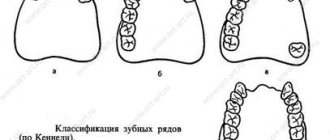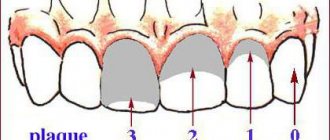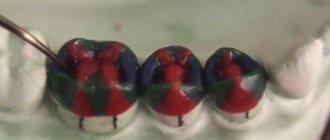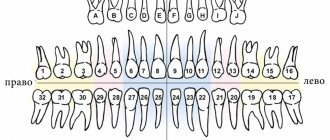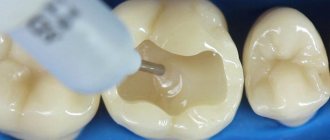An inlay is a microprosthesis that fills imperfections in the crown of a tooth, which allows you to restore its shape and return the functions assigned to it. In fact, an inlay is the same filling, but performed by a technician in a laboratory.
The difference from traditional therapeutic treatment is that the material is introduced into the dental cavity not in plastic, but in solid form, which means that the inlay has visible advantages, the main of which are:
- the strength of the connection, which occurs due to the complete contact of the surfaces;
- the likelihood of restoring angles, cusps and contact points depending on age, as well as existing individual qualities;
- prevention of carious recurrence due to the constant volume of the inlay, as well as due to the precise fit;
- durability and wear resistance, which are determined by the high degree of strength of the material used;
- Due to the density of the structure, which was compiled in the laboratory, the insert does not change its color.
It is for these reasons that replacing teeth defects with inlays is a more preferable option than the usual filling.
Classification of tabs.
Tabs are classified depending on the method of expressing chewing pressure and are divided into:
- restorative. These microprostheses restore the chewing pressure that occurs on the periodontal tissues.
- loading. These structures are used for the rehabilitation of the dentition, and they are used as a support for a bridge-class denture.
- distributing. Such inserts redirect chewing pressure during teeth splinting.
Tabs are classified according to the following criteria:
Grouping of tooth cavities under inlays (according to the location of the defect).
Most often, a dental defect in the coronal lobe occurs due to caries. It is for this reason that the division of this disease according to topographic properties is of great importance.
The division was developed in 1891 by G. Black and involves dividing carious cavities into six classes depending on location. Speaking about the main advantage of this work, it should be noted the simplicity with which a doctor can use the classification.
To create the necessary conditions for fixing the tab, the doctor needs to determine which class the cavity belongs to, thereby preventing the secondary appearance of caries.
The only change that occurred with the classification can be considered the change of classes to letter definitions proposed by Boyanov in 1960. In fact, Boyanov proposed designating surfaces that have cavities.
Today the classification is as follows:
- O are cavities on the chewing planes (occlusal surfaces);
- M are cavities located on the medial plane;
- D - this is on the distal surface;
- MO are cavities that cover both the medial and occlusal surfaces;
- MOD are cavities that cover all three surfaces (occlusal, medial, and distal).
Separation by design features.
Depending on the severity of the defect in the coronal part of the tooth and how the doctor plans to place the microprosthesis, inlays replace missing tissue to varying degrees, and therefore, it is customary to distinguish four (main) types of inlay structures.
- inlay - in this design, the microprosthesis is located centrally, but at the same time does not affect the tubercles of the tooth;
- overlay - in this design, the microprosthesis covers up to three tubercles. It is worth noting that such a design, affecting four tubercles, can already refer to three-quarter crowns.
- onley - the tab touches the internal slopes, creating the effect of an overlay;
- pinley - in a similar design, a microprosthesis is strengthened in the tooth using so-called pins, that is, pins that are located in hard tissues. It is worth noting that the manufacture of such systems for chewing teeth involves covering all the tubercles. As for the front teeth, it is possible to install a pinley with full protection of the vestibular surface, as well as the incisal edge. Simply put, pinlay inlays on canines and incisors look like half-crowns with a pin.
Division depending on the material from which the inlays are made.
Depending on the material used, the tabs are divided into:
- metal models made of titanium, since this material takes root almost 100%;
- plastic inserts (nylon, acrylic, polyurethane);
- ceramic, made from materials such as zirconium, porcelain or titanium oxide;
- composite, they are also called ceramic;
- combined (metal-composite or metal-ceramic).
Depending on the chosen material, the doctor prepares the cavity for the tab and determines its features, but at the first stage, the dentist can prepare the cavity for the tab, based on the diagnosis and the drawn up treatment plan. But such an approach occurs only after a complete clinical examination.
NeoStom – Dentistry website
Fixed denture structures are used to replace defects in hard dental tissues, restore the anatomical shape, function of teeth and facial aesthetics. • Microprostheses: — tab — microprosthesis that restores the anatomical shape of the tooth, filling the defect in its coronal part; — veneer - microprosthesis made of ceramic or composite material, covering the vestibular, both proximal (to contact points) surfaces, and, if necessary, the cutting edge. • Artificial crowns (full and partial) - designs used in cases where restoring the shape of teeth with fillings, inlays or veneers is ineffective and impractical.• Pin structures (pin teeth, artificial crowns on a stump tab with a pin) are used when there is significant destruction of the coronal part of the tooth, when the use of an artificial crown without a pin or without a stump tab with a pin is impossible. To fix the prosthesis, the root canal of the tooth is used, in which the pin is located.
To justify the method of restoring the anatomical shape of dental crowns, clinical data such as the degree of destruction of the clinical crown, localization (topography) and size of the tooth cavity or filling are of particular importance. In the development of the carious process, its localization and depth of spread into the hard tissues of the tooth, certain patterns can be traced, determined by the histological structure of enamel and dentin, and the unequal resistance to caries of various tooth structures. The fissures of chewing teeth, contact and cervical surfaces are most often affected. Based on the patterns of distribution and typical localization of caries, G. Black in 1891 systematized the topography of carious cavities, identifying five classes: • 1st - cavities located in the fissures and natural pits of the teeth, bounded on all sides by dental tissues; • 2nd - cavities located on the mesial and distal surfaces of molars and premolars, limited by tooth tissue on three sides; • 3rd - cavities on the medial and distal surfaces of the incisors and canines with preservation of the cutting edge; • 4th - cavities on the medial and distal surfaces of the incisors and canines with partial or complete destruction of the cutting edge; • 5th - cavities on the vestibular surface in the cervical part of the tooth crowns; There is also a 6th class - cavities in the area of the tubercles of the teeth. In dental practice, the main clinical indicator when planning a method for restoring the anatomical shape of teeth is the degree of destruction of the clinical crown. Destruction of the clinical crown by 1/3, up to 2/3, and more than 2/3 is noted. These guidelines are the starting point for justifying the treatment method. Thus, when the tooth crown is destroyed up to 1/3, therapeutic methods of treatment are appropriate; from 1/2 to 2/3 - the production of inlays is shown; more than 2/3 - the use of artificial crowns. It should be noted that the criteria for clinical assessment of the degree of destruction of the coronal part are in most cases subjective, since they are based on visual assessment. The degree of destruction of the hard tissues of the crown and root of the tooth is recommended to be determined before and after the removal of all softened tissues, after which one can judge the possibility of preserving the remaining part of the hard tissues of the teeth and plan the design of the denture. For a more objective assessment of the degree of damage to hard dental tissues, the method of determining the index of destruction of the occlusal surface of the tooth (IROPD), proposed by V.Yu. Milikevich (1984). The IROPD indicator is defined as the ratio of the size of the area of a hard tissue defect or filling to the area of the chewing surface of the tooth. That is, taking the entire area of the occlusal surface as a unit, the ratio to it (as a part or percentage) of the area of the defect or the area restored with a filling (inlay) is determined: IROPD can be determined indirectly (on a diagnostic model) and directly (in the patient’s oral cavity) by methods. In the first case, to determine the surface area, a transparent plexiglass plate 1 mm thick with a millimeter grid applied to it with a division value of 1 mm2 is used. The plate is applied to the occlusal surface of the tooth with a defect on a diagnostic model of the patient’s dentition. In this case, the sides of the mesh square are aligned with the direction of the proximal surfaces of the teeth. The results are expressed in mm2 with an accuracy of 0.5 mm2. With the direct method, IROPD is determined visually, guided by anatomical formations, using a graduated dental mirror. Currently, computer technologies are used to determine the IRPI. Special programs allow you to determine the areas of objects by color and calculate indices. This technique is more objective and effective, but its practical application is limited by the cost of the hardware base, the availability of software and service capabilities. Determining the degree of destruction of the occlusal surface of a tooth is not only a diagnostic test, but also a determining factor when choosing a treatment method (filling, inlay, artificial crown or pin structure) in order to prevent further destruction of hard tissues and tooth extraction. For IROPV values: • up to 0.3, filling is indicated; • from 0.3 to 0.6 – treatment with inlays; • from 0.6 to 0.8 – treatment with crowns; • more than 0.8, the use of pin structures is indicated.
You might be interested in:
- Treatment with veneers
- Methods for making inlays
- Preparing cavities for an inlay
- Application of tabs (classification of tabs)
- Theoretical foundations of tooth preparation
Related materials:
- Examination methods for defects of hard dental tissues
- Pathology of hard dental tissues
How are tabs used?
- in the form of an independent design that allows you to restore the shape, function and aesthetics of previously unsuitable crowns with IROPS indicators of 0.3–0.6, that is, in the presence of: caries, if filling turns out to be ineffective or cannot be performed;
- tissue damage of a non-carious nature, for example, with wedge-shaped defects or with increased abrasion.
IROPD - index of destruction of the occlusal surface of the tooth
Author: Polilov D.A. — 2022
Many believe that today, with the advent of modern high-strength, low-shrinkage composites, IROPZ has become obsolete, and the indications for direct restorations are much wider than in 1984. However, this index can be extremely useful when working within the framework of voluntary health insurance programs.
According to the clinical treatment protocols approved by StAR, the choice of method for restoring the coronal part of chewing teeth in the treatment of pulp diseases is determined depending on the degree of destruction of its occlusal (chewing) surface according to the IROPD index according to V.A. Milikevich.
Many can say that today, with the advent of modern high-strength composite materials with low shrinkage, the IROPZ index is outdated, and the indications for direct restorations are much wider. This is true.
But it is too early to discount IROPZ. It can be extremely useful when treating patients under Voluntary Health Insurance programs. Since it is the IRPH that determines whether the treatment will be covered by insurance or not.
The role of IROPD in VHI treatment
Real case. During a medical and economic examination, an expert doctor from an insurance company sees a large filling on the Rg image. He says that this is not a filling, but a direct restoration and writes off the cost of all the treatment performed. It's a shame? Not that word. In this case, the ideal way out of the situation would be IROPD, if the doctor had bothered to take a picture of the occlusal surface of the tooth before starting treatment, at least on his smartphone.
Another situation. The tooth is badly damaged, but the patient insists on treatment covered by insurance. After taking a photograph of the occlusal surface, we calculate the IROPV and call the insurance company to coordinate treatment under insurance. The insurance company will definitely deny coverage, since the fundamental document is the StAR clinical protocols, and they refer to the IRPH. The patient is forced to agree and pay for the treatment at his own expense.
Index history
The IROPZ index was proposed by V.Yu. Milikevich in his doctoral dissertation (1984) as an indicator (index) of the degree of destruction of hard tissues of the crowns of chewing teeth with defects in the hard tissues of chewing teeth (premolars, molars) according to class I-II according to Black. It represents the ratio of the dimensions of the “cavity/filling” area to the entire area of the occlusal surface of the tooth.
Rice. 1. Typical models of destruction of the occlusal surface of chewing teeth
Thus, according to Milikevich:
IROPS = Cavity/Filling Area: Area of the chewing surface
With IROPI indicators of 0.2 – 0.4
The filling method is used. After endodontic treatment, a temporary filling (bandage) can be placed if it is not possible to place a permanent filling on the first visit or to prevent possible complications. Permanent filling is carried out in one visit.
With IROPV > 0.4
shows the manufacture of inlays from metals, ceramics or composite materials.
With IROPV > 0.6
production of artificial crowns is shown
With IROPV > 0.8
the use of pin structures with subsequent production of crowns is shown.
To calculate the IROPZ index in practice, Milikevich proposed using plexiglass and graph paper (paper with a grid applied with cells with a side of 1 mm - at that time such paper was widely used in drawing). There were no computers or digital cameras back then.
Method for calculating IRPZ
Today there is a simpler and accessible way for every doctor to calculate the IRPI. We photograph the tooth from the occlusal surface using any camera (microscope, intraoral camera, camera or smartphone through a mirror) and transfer the image to the computer.
Image processing in a graphics editor
For example, in Adobe Photoshop. We turn on the display of the grid in the menu View – Show – Grid. If necessary, you can configure the grid parameters in the Editing – Settings section. Expand the image and align it to the edges of the grid (Ctrl-A, Ctrl-T). We mark the filling/cavity zones with the letter “P” in those squares where the area of the destroyed tooth surface is significantly larger than the preserved one. When calculating the total area of the occlusal surface, we take into account the squares where the tooth tissues occupy more than half of it.
Rice. 2. An example of calculating IRPI on a computer.
In our example, shown in the picture, the total area of the occlusal surface of the tooth is 28 squares, and the cavity area is 13 squares. Thus, for this tooth IROPZ = 13: 28 = 0.46. This means that in this case, restoring a tooth with a filling is not indicated, but requires the manufacture of an inlay made of metal, ceramics or composite.
Saving the IRPZ calculation
It is recommended to save the original images and calculation of the IRPI in the patient’s electronic medical record in the Dental4Windows program so that they are always at hand in case of an audit by the insurance company.
Adding photos and any other files is done in the Patients
,
Documents
. In this case, photographs and x-rays are automatically displayed when viewing the dental formula (Dental Map) on the right side.
If you have questions about this method for determining IROPD, suggestions, or you want to discuss anything, we invite you to join our open group on Facebook: https://www.facebook.com/groups/Dental4Windows/. We'll talk there. See you in touch!
Literature
1. Clinical recommendations (treatment protocols) for the diagnosis of dental pulp disease. Approved by Resolution No. 18 of the Council of the Association of Public Associations “Dental Association of Russia” dated September 30, 2014
2. Milikevich V.Yu. Prevention of complications in case of defects in the crowns of chewing teeth and dentition: Abstract of thesis. Dis...Dr. med. Sci. - M., 1984. - 31 p.
